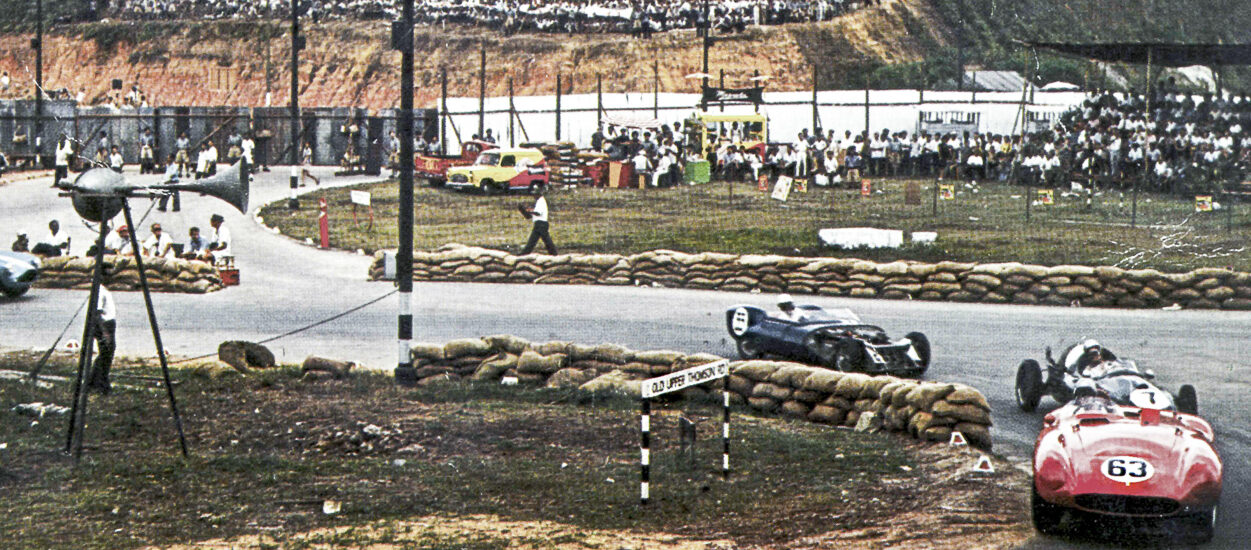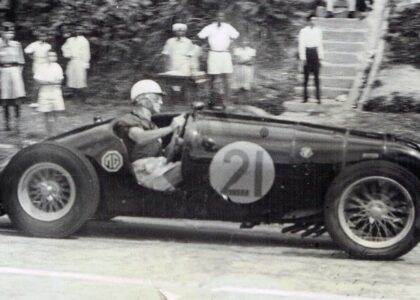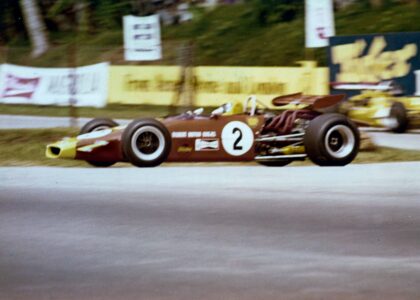The Ferrari 500 Mondial in the Far East
By Eli Solomon
What began as a study of Asian automobile advertising of the late 1950s is now a standalone article on a unique race car that resided in Hong Kong, Singapore and Selangor between 1955 and 1971. Adestne quisquam de Maranello? You might want to sit down for this one.
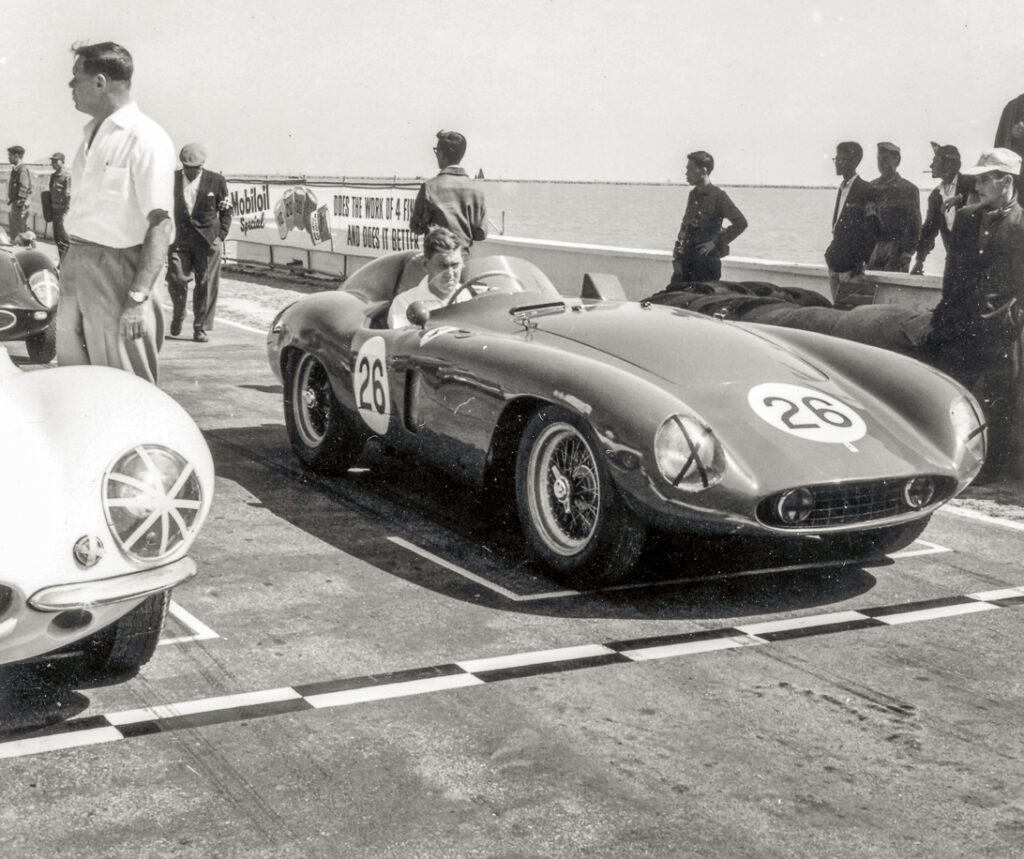
Jan Bussell with the Ferrari on pole for the 1960 Macau Grand Prix, alongside an XKSS and a Porsche RS Spyder.
OBSCURUM PER OBSCURIUS
OBSCURUM PER OBSCURIUS: At the Gap Hill Climb in Singapore in May 1959, a very fast and desirable red sports car made its maiden appearance on the island. Chan Lye Choon, who ran car importer Eastern Auto, had shipped the Hong Kong car over. It had a newish 3-litre overhead cam four-cylinder engine and made all the right noises, plus it had Asian history dating back to 1955! Not a plus point on the international market but here was a genuine Ferrari sports car in Singapore, fresh from a restoration in Hong Kong. If there was a sports car to match the wealthy towkay’s Aston Martin DB3S, this had to be it.
This Ferrari, a Series II 500 Mondial Spyder with coachwork by Sergio Scaglietti coachwork, chassis #0528MD, was apparently first sold to Conte Carlo Leto de Priolo of Milan. The car was raced in Italy, but always failed to finish – blown engines generally the cause. In June 1955, de Priolo returned the car to the factory and demanded (and it seems, received) his money back from il Commendatore Enzo Ferrari. The Mondial was sold to Lieutenant Mario Lopes da Costa of Macau who entered it for the second Macau Grand Prix held on 6 November 1955. The Lieutenant’s co-driver in Macau was Fernando de Macedo Pinto, one of the three men behind the design of the Macau Guia circuit. Pinto and the Lieutenant had visited the Ferrari factory earlier in the year to purchase the car.
The Lieutenant had damaged it in practice, the #14 car clouting a wall. But his time still put the car on the front row for the 60-lap Grand Prix, alongside Doug Steane’s Mercedes 190SL and Robert Ritchie’s Austin Healey 100 (on pole). He started the race but cooling issues saw the car DNF on lap 7, after another altercation, this time with sandbags. In 1956, now carrying the rank of Commendatore, the dashing da Costa put the car on the front row again. This time, he finished second in the Grand Prix.
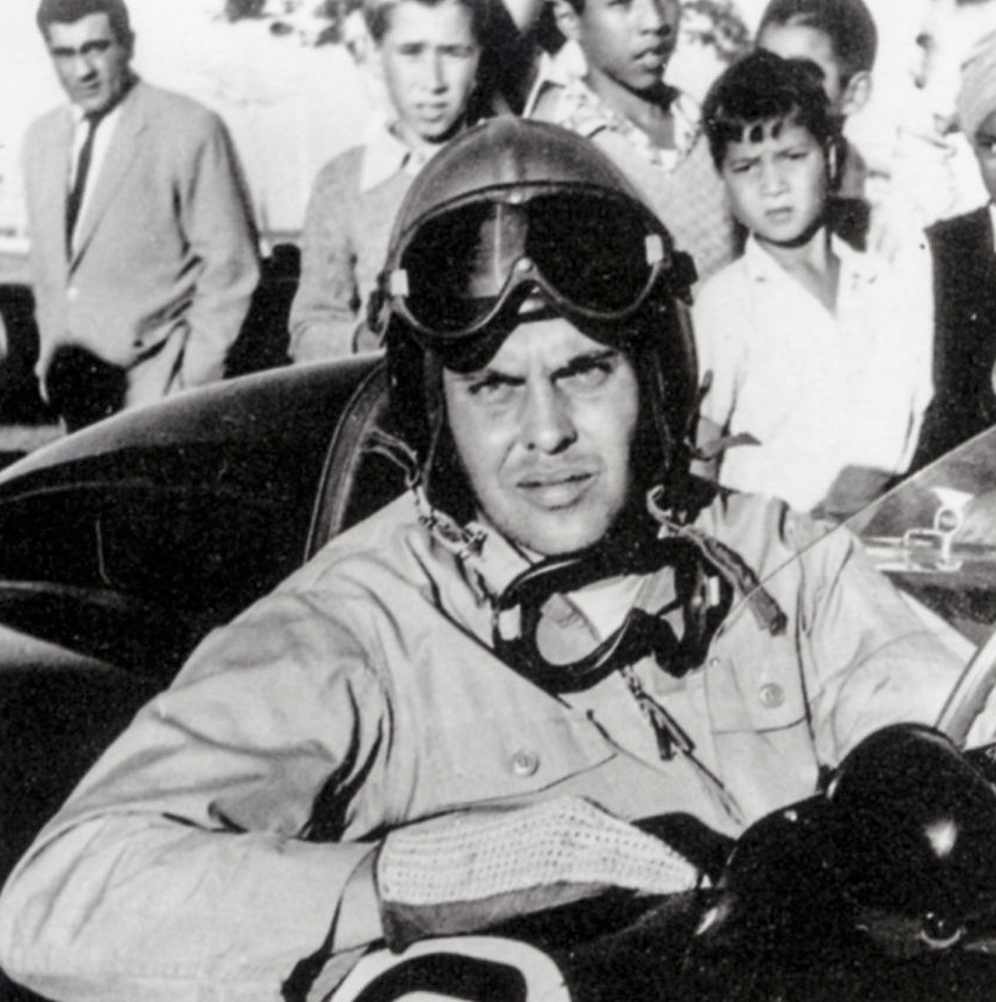
George Baker in the Ferrari. Photo from Colour & Noise – 40 Years of The Macau Grand Prix.
NEW SPEED SHOP
NEW SPEED SHOP: The Mondial was then sold to a 33-year-old 210-lb cigar-smoking Pan-Am pilot and entrepreneur from New York, George M. Baker. Baker had arrived in Hong Kong in 1953 and soon supplemented his income through his import/export company, International Service Corporation Ltd, mainly automotive products and accessories. Baker put the Ferrari on pole in the 1957 Macau Grand Prix but over-revved the motor during the race, venting a hole in the block which he blamed on the tacho needle falling off. So much for the four-cylinder 2-litre twin overhead cam motor. Nobody said it wasn’t a fast car.
A new motor was needed for the following year’s Macau Grand Prix, so Baker, owner of Hong Kong’s newly-established automotive products importer International Service Corporation Ltd, visited Maranello to see about a replacement – preferably something bigger, like a 750 Monza 3-litre motor, which Mr Ferrari agreed to provide. Perhaps the deal included a distributorship contract for Ferraris in Hong Kong as well. The result was that the Mondial was now a Monza for the 1958 Macau Grand Prix. And, sure enough, Baker put it on pole.
By now Baker quit Pan Am and was focusing on his businesses in Hong Kong. He now had his own showroom on Seymour Terrace, Mid-Levels, Hong Kong, called The Speed Shop (which was in operation between 1958-1966). The Speed Shop quickly expanded into the dealership business when it secured the Far East distributorship of Ferrari (and other sports car brands such as Abarth and Berkeley). There were several other brands that the company carried – like fiberglass body builders Microplas (which made the Mistral body for Buckler and other manufacturers) and Devin. At the very same time in Singapore, Bernard Sydney Arnold operated his speed shop carrying the identical brands. Even their adverts were somewhat identical. Both carried Devin bodies. As in Bill Devin’s Devin Enterprise fiberglass shells? Hold that thought for a second [see Appendix].
Baker may have had the fastest car in Macau in 1958, but the circuit didn’t take any prisoners and the car had a recognised affinity for walls. While going for broke into Reservoir Bend, a back tyre blew and the red sports car careered into the sea wall at well over 100mph. There couldn’t have been a single panel that was left undamaged by the incident.
Baker ditched the Ferrari and put his money on a local special, The Beast. There must have been a genius of a panel beater available to Baker because by mid-March 1959, the Ferrari was back in action for the Motor Sports Club of Hong Kong’s slalom meet at Sek Kong, this time in the hands of Martin Redfern. Oil pressure failure put the car out of action. Genius panel beater…or a shell sourced from Devin? [see Appendix]
NO HORSING AROUND
NO HORSING AROUND: Long in the tooth, the car was put on the market and by May 1959 it was in Singapore (so was Martin Redfern’s Hong Kong-built Bamboo Mk1), resplendent in red and entered for the May 1959 Gap Hill Climb by its new owner, Chan Lye Choon 1. The Ferrari finished behind Bill Wyllie’s Buckler DD2 Mistral Special in the Unlimited class. We don’t know why the tycoon flipped the car so quickly; perhaps he’d realized it wasn’t something he could win in, perhaps he already had a ready buyer in mind. Nonetheless, it found a new home in a bungalow on Goodwood Hill in Singapore. Its new owner was Malayan Airways pilot Francis Jan Bussell 2.
Rare footage of the Ferrari in action in Singapore 1959/1960. Rewind Media Archives
Bussell now thought he had something amounting to a suitable race car for the Macau Grand Prix in November 1959. But there was work to do so he set off for Kuala Lumpur on a test run see how it would perform, an ideal set of winding roads with different gradients. “It was the only way to try it out, but it dropped a valve and I had to send the engine back to the Ferrari factory,” he shrugged when I asked him about his experience and this expensive test drive. His Macau 1959 aspirations had been dashed but he was undaunted.
Bussell paid Maranello a visit while on long leave home and observed his engine being put back together. Querying one of the factory mechanics what the torque setting for the camshafts were, he got a reply he wasn’t quite expecting: “Ees a tight-a, not-a too tight-a, tight-a enough-a.”
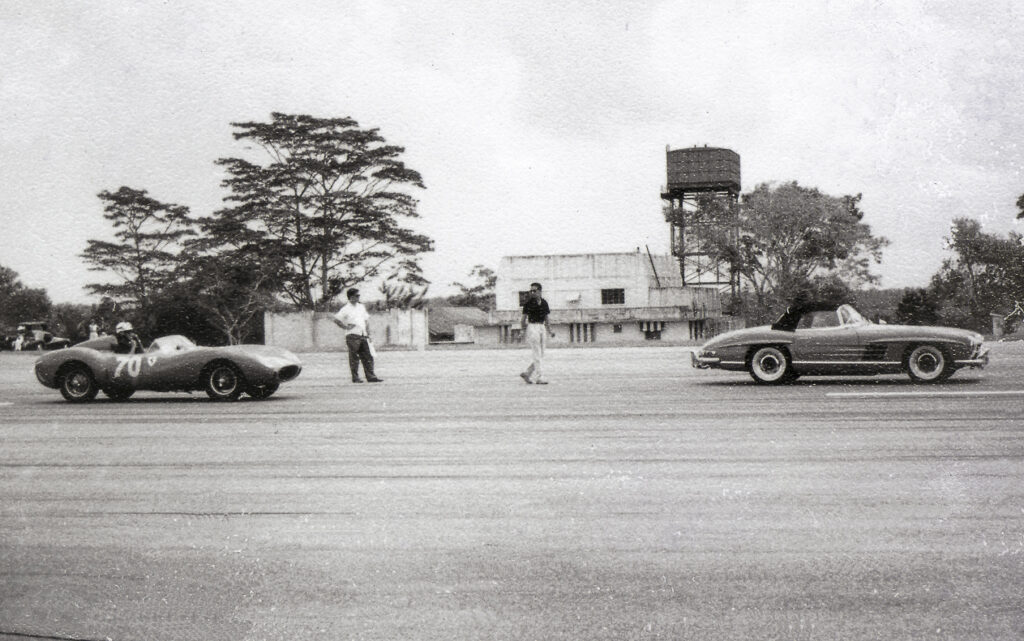
Stanley Leong with his #70 S.L. Ferrari at the Seletar Sprint. The car had an MGA with the ex-George Baker 2-litre Ferrari Mondial engine.
The Ferrari would have to wait till 1960 to see any action. Would the car be ready for the Johore Coronation Grand Prix early in the year, the first Grand Prix in Malaya since 1953? It couldn’t. Interestingly, local architect Stanley Leong had the Ferrari’s two-litre (1985cc) Mondial motor, purchased from Baker while Leong and his bride Pauline were honeymooning in Hong Kong! It was installed in his S.L. “Ferrari”, a very attractive car that had been locally fabricated using his MGA’s chassis as donor. Another Scaglietti knock-off.
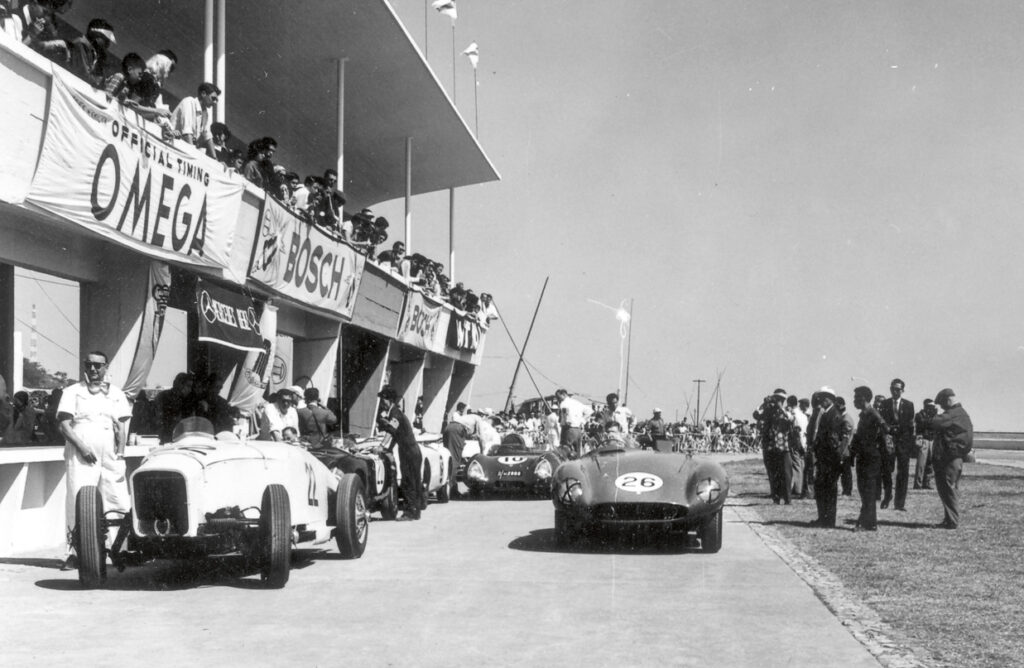
Jan Bussell and his Ferrari alongside Freddie Pope and his bare-bones XK Special, Macau 1960.
Meanwhile, Bussell was sure that he now had the right car for the 1960 Macau Grand Prix. He’d seen it race there in 1958 when George Baker put it on pole. Now it was freshly repainted and had an equally fresh factory engine rebuild. He’d be right up there with the rest of the favourites – Martin Redfern’s Jaguar XKSS, Grant Wolfkill’s Porsche RS Spyder, Peter Heath’s Lotus Eleven, George Baker’s Beast, even his Singapore compatriot, Freddie Pope in a stripped-down-to-bare-bones Jaguar XK. But as well all know, nothing ever goes to plan when it comes to shipping engines around the world – the motor only arrived in Singapore the day the car was to ship to Hong Kong. Installation therefore took place in Macau’s Naval Dockyard, hardly the ideal place to work on a race car. Still, he managed to put the car on the front row, alongside the Jaguar XKSS and Porsche RS Spyder. The car was fast, but the brakes were marginal, and at the end of the race Bussell was a lap down, in third place, without brakes and with a body that was rather battle-scarred by that love-hate relationship with Macau’s walls. Well, at least we know that it wasn’t a fiberglass shell and he did take home a trophy for his efforts, the highest placed Malayan in the race (ahead of Pope in an XK Special, fellow pilot Phil Caroline in an Allard J2X and Bill Wyllie in his Auto Union Special [see ON THE STROKE OF TWO].
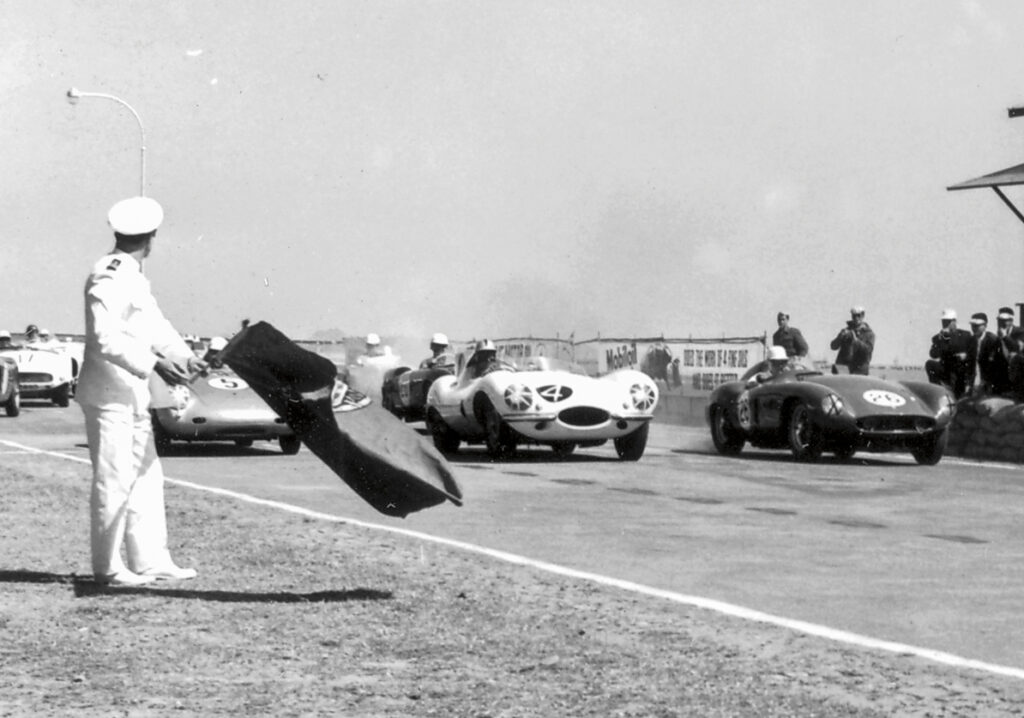
And they’re off – the 1960 Macau Grand Prix.
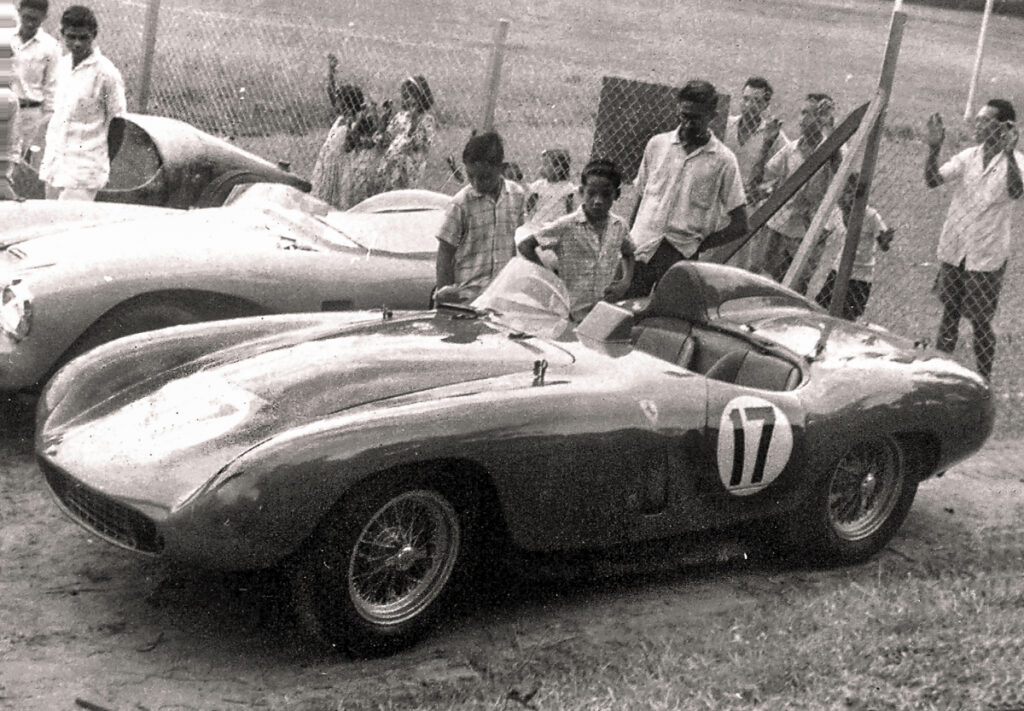
In the Paddock for the 1960 Johore Coronation Grand Prix alongside a Scaglietti knock-off.
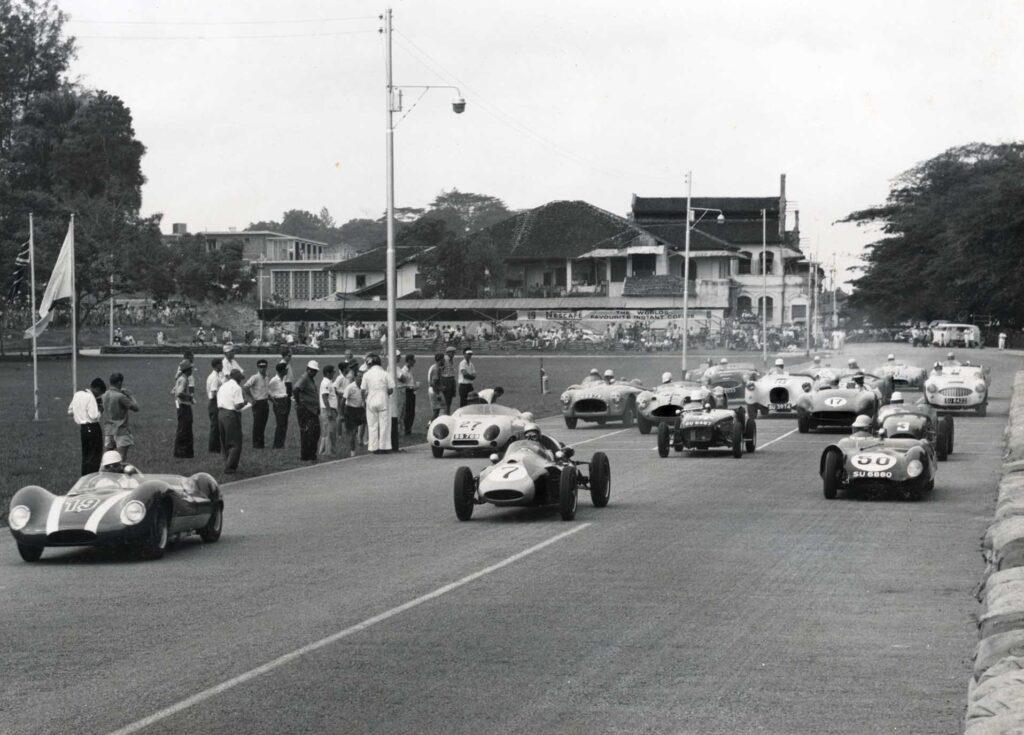
Start of the 1961 Johore Grand Prix. Bussell is in the #17 Ferrari. On the front are a Lola Mk1 (#19), T51 Cooper FPF (7) and a Lotus 17 (#50).
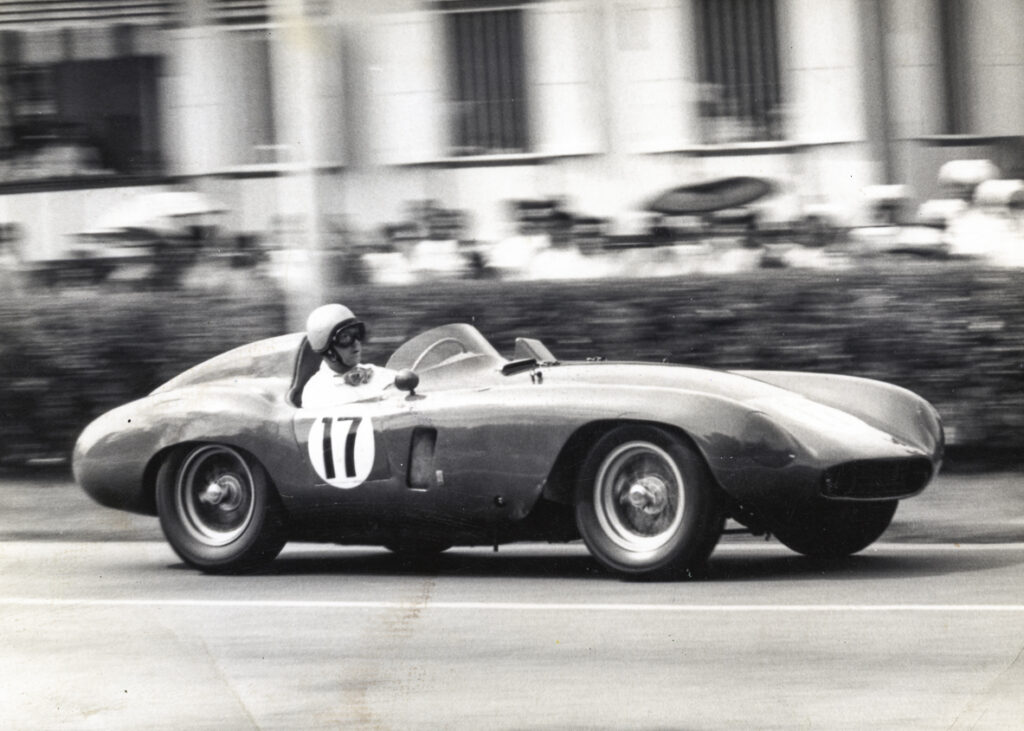
Jan Bussell with his Ferrari in the Johore Grand Prix.
Bussell wasn’t done with the car just yet and the Johore Grand Prix beckoned in June 1961, one more crack at Grand Prix victory. Running number 17 for the Johore race, the car broke down with fuel issues on lap 54 and was unceremoniously pushed back to pits from the Court House. Nothing terminal it seemed, but the sharp-eyed car-spotter would have noted a certain Ferrari “Monza” 1955 sports/racing (with spare rear axle ratios etc.) offered for sale in the Singapore papers at S$16,500 on 11 July 1961. The seller was Jan Francis Bussell of 11 Goodwood Hill, Singapore. Two weeks later the price was knocked down to S$12,500, but not before the 23rd July Sembawang RASC Summer Sprint at the Nursery Circuit in Singapore where the number 17 car did a single run before scratching. One presumes that it wasn’t the sort of car that appealed to local tastes when it came to maintenance, or it may have been pricing, or much too much low-balling by the local punters.
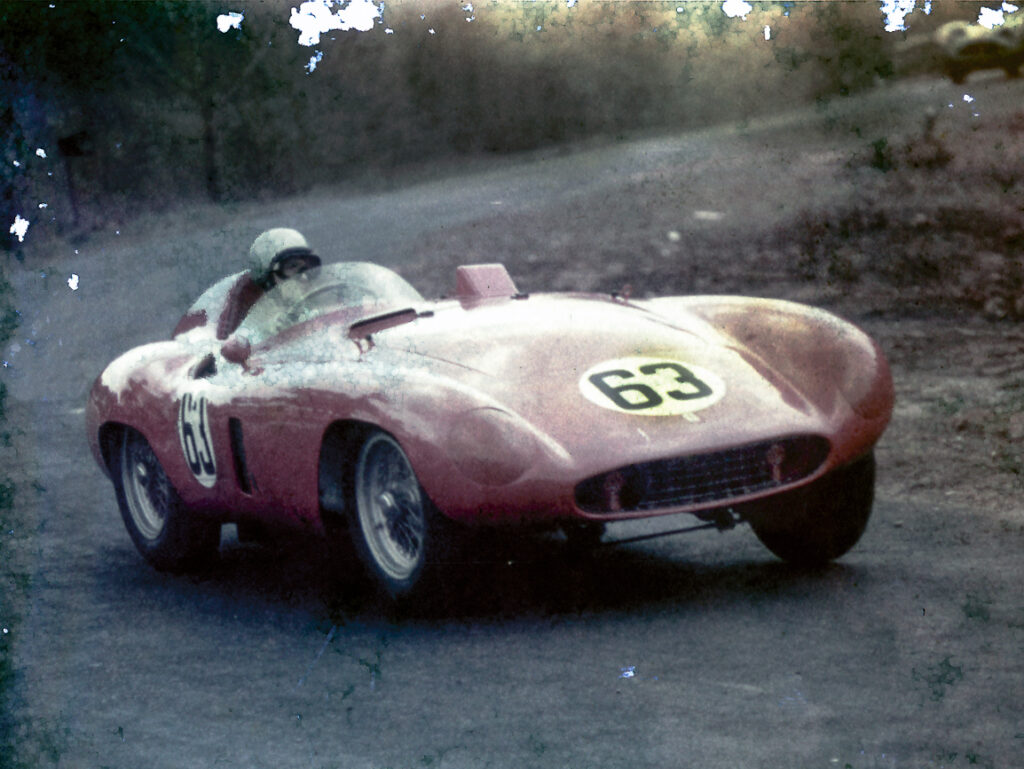
A rare colour slide of the Ferrari in action at the inaugural Singapore Grand Prix, 1961.
Once more, Bussell readied the car for another Grand Prix – this time, the inaugural Singapore Grand Prix on Upper Thomson Road in September 1961. It was right up there as a front runner, but sadly, he had to pull out with mechanical trouble on lap 32 of the main race. He wasn’t quite done because on 22nd October 1961, he finished third in the Racing Cars class at the Gap Hill Climb.
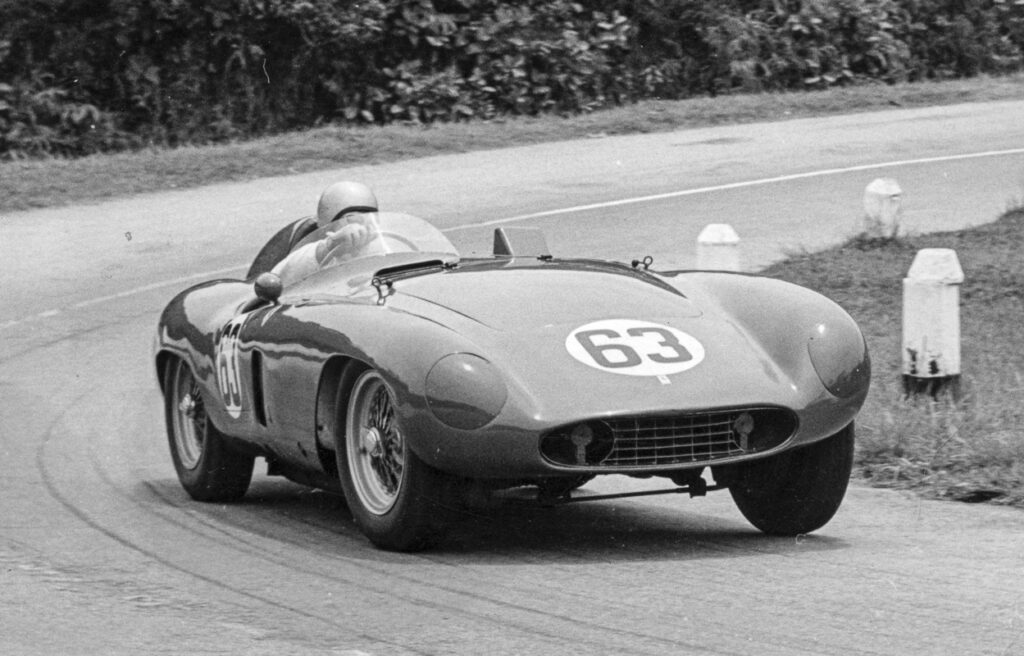
Racing up the Gap in Singapore.
EQUESTRIAN MANOEUVERS
EQUESTRIAN MANOEUVERS: There was life in the old horse (pun intended) because a month later, the Ferrari, running number 63, finished first in the Sports Cars Unlimited and Racing Cars class for the Upper Thomson Road Sprint. In February 1962, the car was once more offered for sale – now priced at S$8,500. Not long after, Bussell moved to Kuala Lumpur to start his aviation charter business, Malayan Air Charter. Bussell’s Torque Shop Singapore (circa. July-August 1960), which handled Alexander conversions and camshafts for Mini, Austin, Ford, and Triumphs etc, was relocated to Jalan Sungei Besi in Kuala Lumpur. Bussell’s Fribus Riley Special and his Ferrari were trailered over as well.
Look at it this way. The Toyopet Tiara was listed in Singapore at $5,995, the Toyota Crown at $6,975, the new Ford Consul at $6,595 and Volvo’s 122S Amazon at $8,885. A Ferrari Monza (nee Mondial) for the price of a Volvo Amazon and no takers? The car featured on the entry list for the 1962 Grand Prix in Singapore, entered by one R. Crombie (#39).
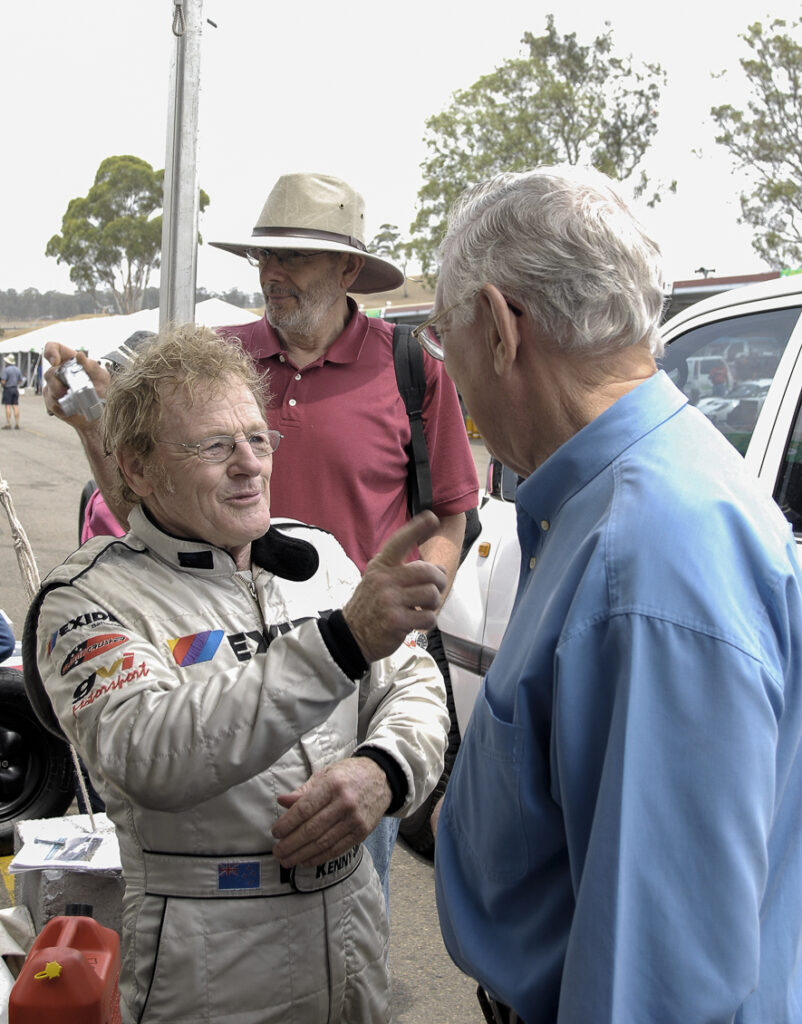
Ken Smith meets Jan Bussell again, 2006 Tasman Revival at Eastern Creek.
Had Bussell lost interest in the car with its heavy maintenance cost? He was now based in Kuala Lumpur, his air charter business was growing rapidly, and one had to have a fairly modern race car to stay competitive. The Ferrari was packed away and forgotten for nearly a decade…until a pair of enterprising Kiwis, masked as race drivers (they really were race drivers), showed up at Torque Shop’s Jalan Sungei Besi garage with a container in 1971. 3
Words By Eli Solomon
References:
Newsome, Phillip. Colour & Noise – 40 Years Of The Macau Grand Prix
Solomon, Eli. Snakes & Devils – A History of the Singapore Grand Prix.
Vercoe, Graham. Historic Racing Cars of New Zealand. Reed Books, 2001
Lunch with Champions – Ken Smith. Rewind Magazine Issue 014, April 2013
Though Their Eyes. Rewind Magazine Issue 020, October 2014
Torque Shop – Bussell’s Berkeley to March. Rewind Magazine Issue 022, May 2015
Ferrari Icons in Singapore. Rewind Magazine Issue 026, January 2016.
Projec4 Asia – The Racing Archives. Rewind Magazine Issue 035, July 2017
Just The Right Amount of Torque. Rewind Magazine Issue 038, January 2018
Hong Kong Motor Sports Club Yearbook – 1956-1957; 1957-1959; 1959-1961
http://www.barchetta.cc/english/all.ferraris/detail/0528md.500mondial.htm
Appendix
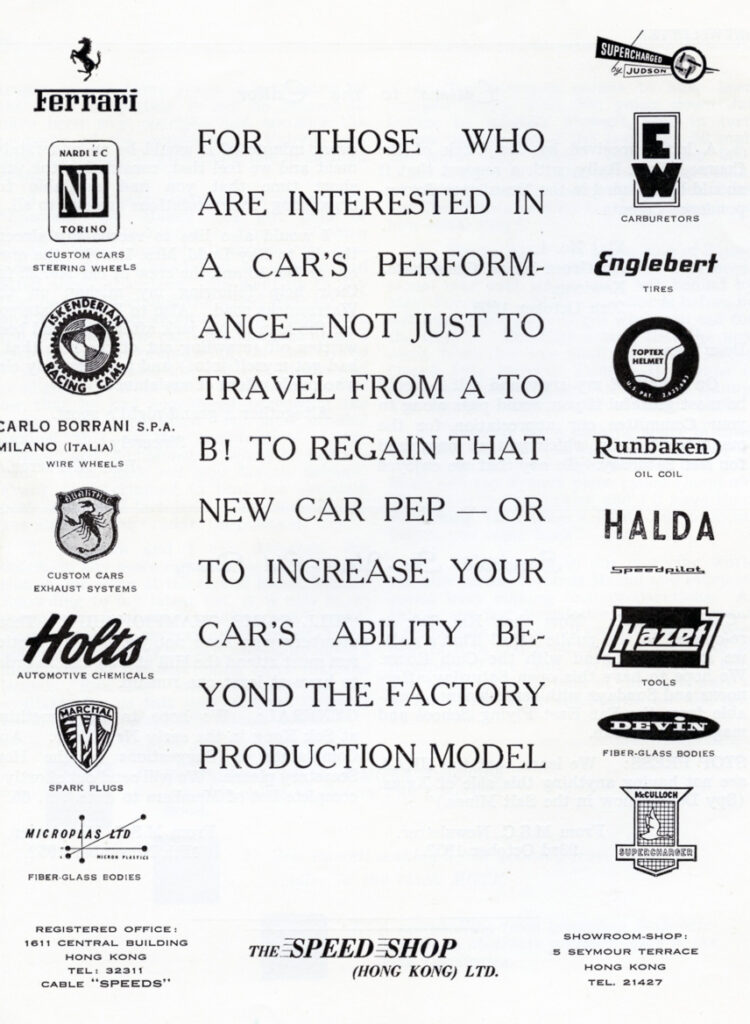
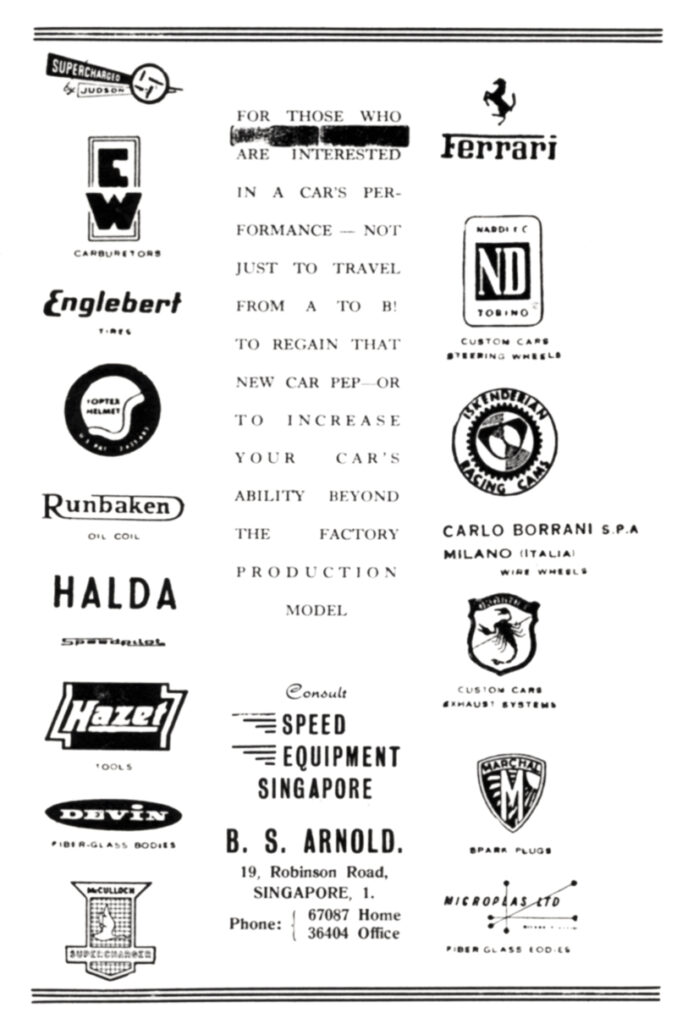
Let’s take a step back and have a look at what Bill Devin was up to. The most commonly attributed source for the Devin body’s shape is that it was developed from a mold taken off an Ermini 357 Sport 1100 with aluminum bodywork (by Italian Sergio Scaglietti). The Ermini’s body closely resembled the design that Scaglietti had done for the larger Ferrari 750 Monza, and some of Devin’s own early ad copy refers to these bodies as Devin Monzas. Back then there was no internet, no 24-hour courier deliveries, no cellphones. So you had to be well-read – i.e. you needed to have subscriptions to Autosport, Motorsport, and the American car magazines like Road & Track and if you were George M. Baker with The Speed Shop and the Devin agency, well, what were the chances the 500 Mondial Spyder’s repair panels came from Devin? This isn’t a conspiracy theory, just an idea that came to mine because of the Devin connection with George Baker (and with Singapore Devin agent Bernard Arnold). Remember that Baker and Arnold carried similar brands (a case of Singapore copying Hong Kong). These brands included Weber Carbs, Judson superchargers, Nardi steering wheels, Iskenderian cams, Borrani wheels, Abarth exhausts, Marchal spark plugs, Helda lighting, Toptex helmets, Englebert tyres and fiberglass bodies from Microplas Ltd and Devin. Baker’s Seymour Road Speed Shop quickly expanded into the dealership business when it secured the Far East distributorship of Ferrari and Berkeley. And guess what, so did Bernard Arnold’s Speed Equipment Singapore of 19 Robinson Road.
Footnotes
- For more on Chan, see For The Price Of A House
- For more on Jan Bussell’s racing, particularly with his March 73B, see RIDES OF MARCH – Part 1 & RIDES OF MARCH – Part 2
- Ken Smith has been in the motor trade for a long time. Even back in 1971, he always had an eye for a good deal. When the Rewind Magazine team interviewed him for a Lunch With Champions article a few years ago, Ken recounted the story of how he and fellow Kiwi racer Graeme Lawrence they came upon the Ferrari. “Graeme and I were having a drink in a hotel in Singapore [they were there for the 1971 Singapore and Selangor Grand Prix in Easter] when we heard of an old Ferrari. It was an early 50s 2-litre four-cylinder Ferrari 500 Mondial sports car. It had been lying in Jan Bussell’s workshop in Sungei Besi in Kuala Lumpur for years. Graeme and I bought it and shipped it home to New Zealand for about NZ$2000. My dad later bought Graeme’s share and we eventually sold it to DK Engineering, a Ferrari restorer in the UK, for a much, much bigger amount.” There is a twist to the story and it involved Formula 1 Kiwi racer Howden Ganley, who had already sold Bussell a Brabham and McLaren (M4C-1). If the McLaren involved a part cash payment and part car exchange it certainly wouldn’t have aroused an iota of interest but if the car that was part of the swap happened to be classic Ferrari Monza/Mondial, you might just sit up and take note. In the end Howden never got his Ferrari, just a full cash settlement for the McLaren.

